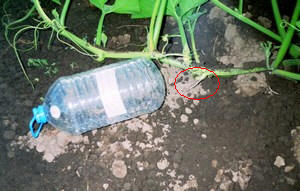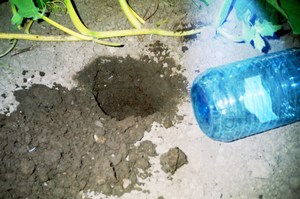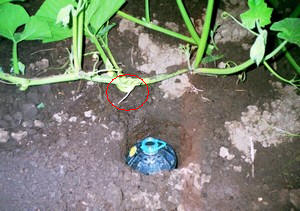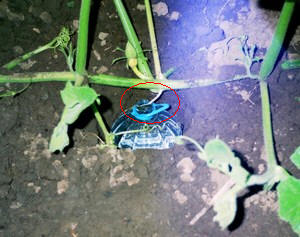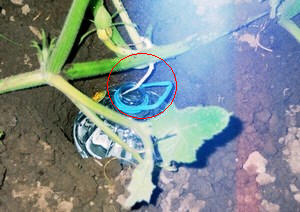GIANT PUMPKINS / SQUASHES GROWING
DIRECT ROOT FEEDING
| My Seedlist | GIANT PUMPKINS | Seed
exchanges / Seed swaps Links |
||
| Direct Root Feeding | Sun Looking Leaves | Connecting plants by grafting | ||
Old text, but still useful
To the begin with, I want to apologize for my not so good English (which is self-learned). I hope that you will understand the most important things. If something sounds to you wrong, please let me know, and I will change it.
Introduction
My name is Hristo, I live in Bulgaria, and want to share with all AG growers the technique that I use when growing Atlantic giant pumpkins, since I'm growing AG's (2003). I call that technique "Direct Root Feeding" (DRF). As you will see this technique is very simple, and because of that I believe, that maybe someone already use it, but I do not know of that, so...
DRF will be especially helpful to those grower who's AG plot(s) are not well prepared and the soil is imbalanced. That technique can be useful and to the so-called "heavy hitters". Especially if they want to experiment with different feeding programs, without the need to change their plot's soil composition!
Short pre-history
My #1 hobby is to grow unusual (and tasty) edible (mostly edibles) plants, and especially fruits. My #2 hobby is to exchange seeds of such a plants with people from all over the world.
Till 2002 I didn't knew that the pumpkin/squash can reach 300+ kg. / 660+ lb. When I learned that that is possible, I was hooked (since I'm growing and many other plants, I can't tell that I'm addicted, but for sure it is real pleasure for me). For 2002 I did not found 'Atlantic Giant' variety seeds, but I trained with 'Big Moon'. For 2003 season I received some AG seeds with unknown background (now they are proven under 400 (lb.) :-)), but despite that they were good for me. Having AG seeds and knowing that my soil is unprepared and pretty imbalanced (for example: P2O2 - 3090 ppm; K2O - 2020 ppm; Fe - 2.12 ppm; don't know - Ca, Mg, S, B, CEC, %BS) I started to think - how can be combined the easy of the classical soil plant growing, and the advantages of the hydroponic growing. Because most cucurbits are very suitable for such a combination, I didn't thought much...
Here I want to thanks to the people who sent me AG seeds, and personally to Michel White who sent me proven seeds. Because of these seeds, now I can share my experience. Which is:
DRF step by step
Look the pictures and you will understand (sorry for their bad quality).
Placing the hydroponic container (the bottles shown on the photos are 10 l. / 2.2 gal.):
When it "takes" (if didn't "takes" - change the water/nutrients/hormones and wait till "takes"), start your feeding program. There is many recipes for making nutrient solution depending on the kind of the plant. But they all are only for hydroponic growing (only), and are not always suitable for combined (soil + hydroponic) growing. For example: in my soil the P and K levels are extremely high, and because of that I do not need these elements in my hydroponics. It is much better you to make the mixes depending on your soil composition and your aims.
Few rules (most of them learned the hard way):
For more comprehensive explanations see "Useful Hydroponic Links" here, or search Internet.
- Use transparent containers. This will allow you to see at any time the roots. But obligatory cover the containers with something opaque. If that opaque material is with dark colour, then cover it to say with white cloth to reflect the sun rays and to decrease the temperature.
- Use distiled or clean rain water. If you use any water and that water contains carbonates (as mine), these carbonates can react with some salts (example - the sulfates SO4) and make them unavailable to the plant (sediment). If you can't provide distiled or clean rain water, then use the water that you have, but if is hard water (contains carbonates) - neutralize them to about pH 6.0.
- Don't waste your time using usual fertilizers to make nutrient solution. Buy from some specialty store pure salts (a chemical substances). They are much more expensive, but you need only a bit of them.
- When choosing the salts, remember that some salts even if they contain some plant nutrient(s) are "inedible" even toxic for the plants. Sounds complicated? No, it is not! Because you need only once to learn which salts are appropriate, and how they can be combined.
- Don't mix salts in concentrated form. Keep particular nutrients separated in the concentrated form because of the fact that many nutrient combinations will precipitate.
- The best concentration of the nutrient solution is between 500 - 1500 ppm / 0.05% - 0.15% (0.5 - 1.5 g. salts per 1 litre water), depending of plant's growing stage. If the concentration is (much) higher, for the plant will be difficult or even impossible to uptake the water and the nutrients (to "drink").
- After dissolving the salts in the water (makeing the nutrient solution) check out the pH - the best is if it is between 5.8 and 6.4. If not - adjust the pH level. (Note: there are needed 2 pH adjustments - 1st - adjust the pH of the water (if needed) before adding the salts; 2nd - adjust (if needed) the the pH level of the nutrient solution (i.e. after disolving the nutrients in the water)).
- Aerate the nutrient solution - mechanically - with pump, or
chemically (preferably) - with Hydrogen Peroxide (H2O2).
H2O2 is easy to be used
and will not only supply oxygen, but also will protect the roots and
will do and other beneficial things, which I will not describe here.
Here I will show some data which maybe is not in the Internet. They are
from a Russian book (the plant used for the research is wheat):
Kind of aeration Uptaked for 8 days N (nitrogen) P (phosphorus) K (potassium) Without (control) 0.72 mg. 2.35 mg. 0.74 mg. Mechanical (with air pump) 1.12 mg. 3.57 mg. 1.10 mg. Chemical (with H2O2) 1.64 mg. 6.75 mg. 1.16 mg. Usually the Hydrogen Peroxide is used as follows (3% H2O2):
- at the early stage - 500 ppm (0.5 ml. 3% H2O2 per 1 l. water) every 3-4 days
- afterwards - 1000 ppm (1 ml. 3% H2O2 per 1 l. water) every other day
- Constantly fill up the nutrient solution in the container with distiled / clean rain water (replace the water that the plant is "drinked"). That can be made automaticly.
- Change the nutrient solution at least once weekly
- Share your experience!
This was/is my way of growing, but of course there can be many different ways (modifications), including the used system (different hydro/aeroponic systems).
Does it works for me?
Frankly speaking I did not achieved significant results. But this is because of me, not because the technique (there is no doubt about that that the hydroponic growing works). I do not followed the rules. I know what is hydroponic and how it works, but I have never been used it. I was, and I'm still not enough experienced, and I make mistakes. Till now I have grown successfully only 4 plants using combined feeding - 2 plants in 2003, and 2 plants in 2005 (2004 season was zero season for me).
During 2003 I have been placed 1 bottle (as on the photos above) per plant (and one secondary root per bottle). I maintained the hydroponics from July until the end of season. Because this was my first season I was very enthusiastic and I tended for the hydroponics (and not enough for the plants :-)). I changed the nutrient solution every 3-5 days, added H2O2 every other day. These operations I did properly, but... I used only spring water, which in my area is hard (high of carbonates); I never checked the pH; despite that I knewed that my soil P and K levels are extremely high, mostly I followed the late season formula - 1-2-1... ect. and ect.
The main observations and conclusions for the 2003 season:
- for 24 hours the plant can "suck" up to 2 litres (1 root from 10 litres bottle) (the summer of 2003 was hot and dry, and because I can't supply enough water to irrigate, my soil was too dry, and the plants "sucked" a lot from the bottles)
- after changing the nutrient solution in the bottle, the first noticeable reaction of the plant is after 24 hours.
- I think that one 10 litre container per plant is not enough
During 2005 I have been placed 2 bottles (see photos above)
per plant (and one secondary root per bottle) (I do not include
another plant (713 Sherwood 04) wich was with bad genetic and
didn't produced fruit). Three of them "taked", but not
for long... I didn't cared for them enough - again used spring
water; changed the solutions once at 10 - 15 days; added H2O2
once at 5 - 10 days. Why?
First - because I had great expectations for the 2004 season, but
that season become very disappointing to me - bad genetics, bad
weather, fatal diseases. Because of that I had no expectations
for 2005, and did not cared what will happen.
Second - this year i had to care to much more other plants (more
than 100 varieties of different species).
Despite all careless, 2005 season became my the best season. For sure that is because the seeds - thanks Michel! Again, I'm very excited for the next season, and even prepared few patches, which I will use if I find the seeds that I'm looking for. After that excitement I'm begin to expect... bad season :-)
So, DRF works, but only if is properly used (follow the rules). (I think that it can't totally compensate poor soil and especially soil with low organic matter, even if is properly used. Of course maybe if you place 10 containers of 20 litres / 4.4 gal. each (or even more / bigger)... Share your experience!)
Advantages and disadvantages
Advantages:
- Maybe the fastest method to feed the plant
- Much better than the foliar feeding (logically, but still just my opinion - needs practical confirmation)
- The possibility to be done mistake which is harmful to the plant is very, very, very low
- Gives many possibilities for experiments...
- ect.
Disadvantages:
- One more thing to do ;-)
- A bit tricky work, which needs some experience.
- ??? Share your experience!
Future plans
- I will (maybe) place not only secondary roots in hydroponic
containers, but and one (or more) root which is part of the maine root
system. In this way the combined feeding can start much earlier - few
weeks before the time when can be used for that purpose secondary root.
Also this will help and to understand how the secondary root system works - simultaneously (together / as one) with the maine root system or as an emergency system (as backup / secondary level system) which is "turned on" only when the maine root system can't supply enough water.
Why I'm wondering this? Because I saw how during days with relatively low temperatures and high soil moisture and / or humidity the plant stops to "drink" water from the hydroponic containers. But at same time the fruit still grows, consequently the plant must transpirate (or guttate), consequently the plant must "drink"... If the plant didn't use the secondary root system to supply the water it must use only the maine root system, consequently the secondary root system works as an emergency system. But for secure this must be checked again.
- I will place a hyrdoponic container under secondary root situated on vine after the pumpkin (the fruit). I always placed the containers before the fruit (somewhere between the maine root (the stump) and the fruit). Maybe that will improve the growth of the vine/leafes after the fruit, and as a result and the growth of the fruit.
Share your experience...
Useful Hydroponic Links
Downloads
http://www.agf.gov.bc.ca/ornamentals/floriculture/fertical.xls - An Excel Spreadsheet for Calculating Nutrient Solution Recipes
Guides / Tutorials / Researches...
http://www.hydroponicsonline.com/ - + forum, pictures...
http://www.1-hydroponics.co.uk/web/manual/index.html
http://www.tps.com.au/hydroponics/nutrient.htm
http://members.tripod.com/~busiweb/hydro/
http://www.growingedge.com/basics/start.html
http://www.3rlighting.com/tutorial/tutorial001.htm
http://www.usu.edu/cpl/research_hydroponics.htm
http://www.hbci.com/~wenonah/link.htm#hydro - Hydroponic Salts, Photos of Mineral Deficient Plants
FAQs
http://faq.gardenweb.com/faq/hydro/
http://www.gtghydroponics.com/faq/hydroponics.htm
Publications
http://www.aces.edu/pubs/docs/A/ANR-1151/ - Hydroponics for Home Gardeners
http://aggie-horticulture.tamu.edu/plantanswers/publications/hydroponics.html - Hydroponics as a Hobby
Forums / Lists
http://forums.gardenweb.com/forums/hydro/
Search Internet...
